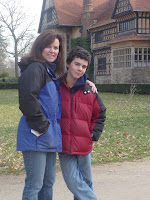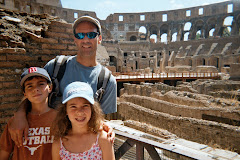 We loved Berlin! Once again we traveled by overnight train for a long weekend of sight-seeing. We endured the longest train ride yet, clocking in at over 14 hours on the delayed ride back to Krakow. Luckily, the trains to Berlin have slightly nicer accommodations. Unfortunately, the upper bunks still weren't working for Ariana, so Corey took a top bunk on the way to Berlin and I slept up top on the way home.
We loved Berlin! Once again we traveled by overnight train for a long weekend of sight-seeing. We endured the longest train ride yet, clocking in at over 14 hours on the delayed ride back to Krakow. Luckily, the trains to Berlin have slightly nicer accommodations. Unfortunately, the upper bunks still weren't working for Ariana, so Corey took a top bunk on the way to Berlin and I slept up top on the way home.
The wall between East Berlin and West Berlin came down in November, 1989, and now it is hard to imagine such an artificial barrier in what has become one cohesive, vibrant city. We frequently couldn't tell whether we were standing in what had been East Berlin or West Berlin unless we looked at the walk/don't walk signals on the traffic lights. East Berlin had a jaunty green man in a nice hat that is now a very popular icon on clothes and access
 ories. His time is limited, however, because whenever such a light breaks, he is replaced with the boring West German style.
ories. His time is limited, however, because whenever such a light breaks, he is replaced with the boring West German style.We have met several friends who visited West Berlin, and even East Berlin, during the cold war. They talk of finding a stark difference between the two countries. Conny talked of being able to view East Berlin from certain vantage points in West Berlin and seeing damage from World War II that no one had repaired even in the 1970's. The buildings that were constructed were plain and often unpainted, leaving the city very grey and bland. My friend Ulrike was able to visit East Berlin as a child because her family received a special invitation to visit relatives there. She said the shops had dead flies in the window, with nothing to sell on the shelves. Everyone who went to West Berlin on the train was instructed to keep their shades drawn as they weren't even allowed to look out on the East German countryside. These stories make it even more amazing to be in the unified city of Berlin now.

We visited Checkpoint Charlie, the designated crossing point for allied forces and foreigners between West Berlin and East Berlin during the Cold War. This border checkpoint between the American and Soviet sectors became a symbol of the Cold War. Near Checkpoint Charlie, we visited the Museum of the Wall. This museum shows all the clever escapes, over, under and through the wall.
Sometimes I felt like it was hard for kid
 s (and adults) to imagine what it must have been like to have a wall running around a city. In
s (and adults) to imagine what it must have been like to have a wall running around a city. In many places, the city has put a double row of stones to mark where the wall used to stand. We even got to see remnants of the old wall, although not in their original position. Once the East German government announced the wall was coming down, the citizens did their best to dismantle it very quickly.
many places, the city has put a double row of stones to mark where the wall used to stand. We even got to see remnants of the old wall, although not in their original position. Once the East German government announced the wall was coming down, the citizens did their best to dismantle it very quickly.We were able to see many of the major Berlin tourist spots, including the TV Tower in Alexanderplatz, the Berlin Zoo, the Aquarium and the Branden
 burg Gate.
burg Gate. 
We also saw the Reichstag, Germany's Parliament. This building has quite a history. The original building was completed in 1894 and saw many governmental changes over the years. The building also suffered extensive damage at the end of WWII. Eventually East and West Germany reunified in October, 1990, and in June, 1991 the new parliament decided that the new capital of the unified Germany s
quite a history. The original building was completed in 1894 and saw many governmental changes over the years. The building also suffered extensive damage at the end of WWII. Eventually East and West Germany reunified in October, 1990, and in June, 1991 the new parliament decided that the new capital of the unified Germany s hould be returned to Berlin from Bonn.
hould be returned to Berlin from Bonn.
 quite a history. The original building was completed in 1894 and saw many governmental changes over the years. The building also suffered extensive damage at the end of WWII. Eventually East and West Germany reunified in October, 1990, and in June, 1991 the new parliament decided that the new capital of the unified Germany s
quite a history. The original building was completed in 1894 and saw many governmental changes over the years. The building also suffered extensive damage at the end of WWII. Eventually East and West Germany reunified in October, 1990, and in June, 1991 the new parliament decided that the new capital of the unified Germany s hould be returned to Berlin from Bonn.
hould be returned to Berlin from Bonn.We spent one day in Potsdam near Berlin. We enjoyed the Russian Village built by Frederick Wilheim III for his friend Csar Alexander of Russia. I really enjoyed the food at the Russian village.

We also enjoyed visiting the Cecilienhof Palace, site of the Potsdam Conference at the end of World War II in Europe. At this conference, decisions by Stalin, Truman and Attlee largely determined the fate of post-war Europe.
...
...


















.jpg)



















































































No comments:
Post a Comment